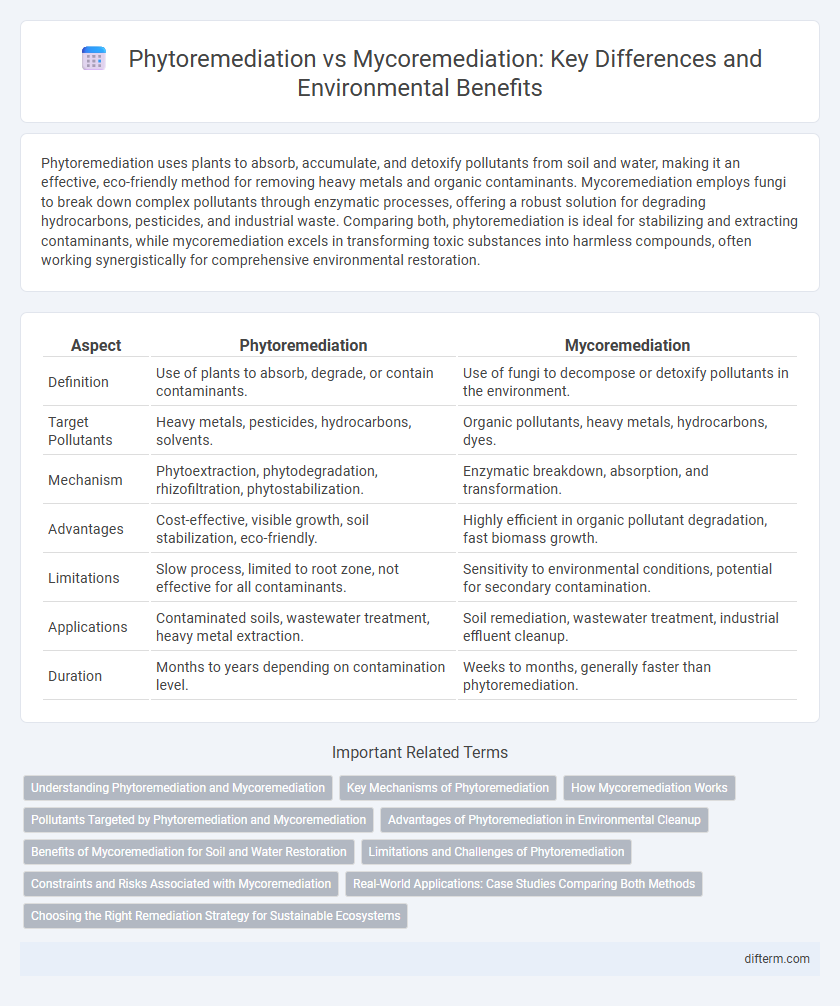Phytoremediation uses plants to absorb, accumulate, and detoxify pollutants from soil and water, making it an effective, eco-friendly method for removing heavy metals and organic contaminants. Mycoremediation employs fungi to break down complex pollutants through enzymatic processes, offering a robust solution for degrading hydrocarbons, pesticides, and industrial waste. Comparing both, phytoremediation is ideal for stabilizing and extracting contaminants, while mycoremediation excels in transforming toxic substances into harmless compounds, often working synergistically for comprehensive environmental restoration.
Table of Comparison
| Aspect | Phytoremediation | Mycoremediation |
|---|---|---|
| Definition | Use of plants to absorb, degrade, or contain contaminants. | Use of fungi to decompose or detoxify pollutants in the environment. |
| Target Pollutants | Heavy metals, pesticides, hydrocarbons, solvents. | Organic pollutants, heavy metals, hydrocarbons, dyes. |
| Mechanism | Phytoextraction, phytodegradation, rhizofiltration, phytostabilization. | Enzymatic breakdown, absorption, and transformation. |
| Advantages | Cost-effective, visible growth, soil stabilization, eco-friendly. | Highly efficient in organic pollutant degradation, fast biomass growth. |
| Limitations | Slow process, limited to root zone, not effective for all contaminants. | Sensitivity to environmental conditions, potential for secondary contamination. |
| Applications | Contaminated soils, wastewater treatment, heavy metal extraction. | Soil remediation, wastewater treatment, industrial effluent cleanup. |
| Duration | Months to years depending on contamination level. | Weeks to months, generally faster than phytoremediation. |
Understanding Phytoremediation and Mycoremediation
Phytoremediation utilizes specific plants to absorb, sequester, or degrade contaminants in soil and water, effectively targeting heavy metals, pesticides, and hydrocarbons. Mycoremediation employs fungi, such as white-rot fungi, to break down complex pollutants through enzymatic processes, making it particularly effective for organic contaminants like petroleum and pesticides. Both methods offer sustainable, cost-effective solutions for environmental cleanup, with phytoremediation excelling in metal-heavy sites and mycoremediation demonstrating superior degradation of recalcitrant organic compounds.
Key Mechanisms of Phytoremediation
Phytoremediation utilizes plants to absorb, degrade, or immobilize contaminants from soil and water through processes such as phytoextraction, phytodegradation, and phytostabilization. Key mechanisms include root uptake of heavy metals and organic pollutants, enzymatic breakdown within plant tissues, and stabilization of contaminants to prevent leaching. This green technology leverages plant biomass and rhizosphere interactions, optimizing contaminant removal while enhancing ecosystem recovery.
How Mycoremediation Works
Mycoremediation utilizes fungi's natural enzymatic processes to break down pollutants, including heavy metals, pesticides, and hydrocarbons, into less toxic compounds. The extensive mycelium networks penetrate contaminated soil or water, secreting extracellular enzymes such as laccases and peroxidases that degrade complex organic pollutants. This biological mechanism enhances soil health and accelerates the detoxification of ecosystems impacted by industrial waste and environmental contaminants.
Pollutants Targeted by Phytoremediation and Mycoremediation
Phytoremediation primarily targets heavy metals, pesticides, and organic pollutants by using plants to absorb, degrade, or stabilize contaminants in soil and water. Mycoremediation employs fungi to break down complex hydrocarbons, dyes, and persistent organic pollutants through enzymatic degradation. Both techniques offer eco-friendly solutions, with phytoremediation excelling in metal uptake and mycoremediation effective against recalcitrant organic compounds.
Advantages of Phytoremediation in Environmental Cleanup
Phytoremediation leverages plants' natural ability to absorb, degrade, or stabilize contaminants, offering a cost-effective and sustainable solution for soil and water remediation. Its advantages include the enhancement of soil structure, prevention of erosion, and habitat creation for beneficial organisms, which collectively improve ecosystem health. The technique also enables in-situ treatment without disturbing the site, minimizing environmental disruption compared to traditional excavation or chemical methods.
Benefits of Mycoremediation for Soil and Water Restoration
Mycoremediation uses fungi to break down contaminants in soil and water, offering efficient degradation of complex pollutants like petroleum hydrocarbons and heavy metals. Fungi secrete enzymes that transform toxic substances into non-toxic compounds, enhancing soil fertility and water quality. This method is cost-effective, eco-friendly, and capable of restoring ecosystems faster compared to traditional phytoremediation techniques.
Limitations and Challenges of Phytoremediation
Phytoremediation faces significant limitations, such as its slow process and dependence on plant growth rates, which can delay contaminant removal in highly polluted sites. It is also less effective for deep soil and groundwater contamination due to the shallow root systems of many plants. Furthermore, phytoremediation may be challenged by bioaccumulation risks and the inability of certain plants to tolerate or metabolize heavy metals and complex organic pollutants efficiently.
Constraints and Risks Associated with Mycoremediation
Mycoremediation faces constraints including the specificity of fungi required for different pollutants, limiting its broad application in diverse contamination scenarios. Risks involve potential fungal toxicity, introduction of non-native species disrupting ecosystems, and uncertain long-term impacts on soil microbiomes. Scalability challenges and the need for controlled environmental conditions further complicate mycoremediation deployment compared to phytoremediation.
Real-World Applications: Case Studies Comparing Both Methods
Phytoremediation has been successfully applied in the cleanup of heavy metal-contaminated soils at sites like the Chernobyl nuclear disaster zone, where sunflowers absorbed radioactive isotopes. Mycoremediation demonstrated effective degradation of petroleum hydrocarbons in oil-contaminated soils, exemplified by fungal species used in the Exxon Valdez oil spill aftermath. Comparative case studies reveal phytoremediation excels in stabilizing and extracting heavy metals, while mycoremediation offers versatile breakdown of organic pollutants, highlighting the complementary roles in environmental restoration projects.
Choosing the Right Remediation Strategy for Sustainable Ecosystems
Phytoremediation utilizes plants to absorb and detoxify pollutants from soil and water, proving effective for heavy metals and organic contaminants in large areas with minimal disturbance. Mycoremediation employs fungi, particularly white-rot fungi, to degrade complex organic pollutants such as petroleum hydrocarbons and pesticides through enzymatic processes, offering rapid biodegradation in contaminated sites with high toxicity. Selecting the appropriate remediation strategy depends on pollutant type, site conditions, and sustainability goals, with integrated approaches enhancing long-term ecosystem restoration and resilience.
phytoremediation vs mycoremediation Infographic

 difterm.com
difterm.com